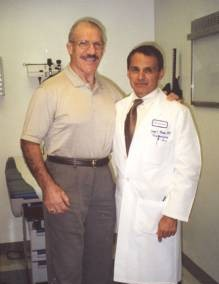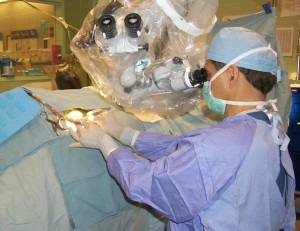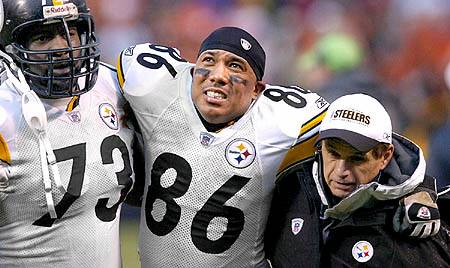Bruno Sammartino
Patient Story
Bruno Sammartino

Age: 65
Surgery: Lumbar laminectomy (L2-3-4)
Date: August 20, 2001
Summary:
- Mr. Bruno Sammartino, world famous professional wrestler, developed progressive back pain, weakness and numbness in his legs
- He said he felt hopeless when “different specialists said something different and I was told that no surgery could help“, before he became Dr. Maroon’s patient.
- One month after the surgery, Mr. Sammartino states “I am already walking 6 miles a day. I believe I have the endurance back that I once had 3 years ago and I am totally pain free and without any numbness in my legs”.
Mr. Bruno Sammartino is a nationally and internationally known superstar in the world of professional wrestling who has enjoyed a remarkable career and generally good health. Mr. Sammartino, however, states for the last 10 years he has had progressive back pain. “The pain in my back was bad, but I was still able to jog and carry on with most activities”, stated Mr. Sammartino, “but once I began to get numbness into my legs I had difficulty walking and soon after even standing for any period of time.” “I couldn’t even walk to my own mailbox.”
These symptoms persisted and he underwent an MRI, brain scan, carotid blood vessel tests and electrical nerve tests. He then was evaluated by both orthopedic and neurosurgical spine specialists. “Everyone said something different and I was told that no surgery could help and if I had surgery, I would then need a fusion to stabilize my spine.
He was subsequently evaluated by Dr. Maroon and found to also have diminished vibration sensation and abnormal reflexes of his legs. The MRI’s revealed severe lumbar stenosis or narrowing of the lumbar spinal canal at L2, L3, and L4. Following a discussion of the risks and benefits of surgery he agreed to have a lumbar laminectomy at those levels on 8/20/01.
Discussion: Mr. Sammartino’s evaluation and duration of symptoms are not uncommon with the condition of spinal stenosis. This condition is sometimes called the “great imitator” because it tends to have the same symptoms of many other diseases. Brain problems such as vascular disease, Diabetes, Parkinson’s Disease and Multiple Sclerosis, all may have similar symptoms of leg numbness and the inability to walk for any distance. The lengthy evaluation process of brain scans and other non-spinal tests often are done to “rule-out” these conditions, but may also delay the discovery of the actual problem. Before sophisticated MRI’s and CT-scans, the condition of spinal stenosis was a common reason for people over 60 years to be confined to a wheelchair.
Mr. Sammartino also expressed concern that he had received such different opinions prior to seeing Dr. Maroon. His experience of having been told that there was no surgery that could help him made him feel “hopeless”. “I didn’t know how I could make it”, stated Sammartino, “I was falling and couldn’t walk more than 60 feet.” The next surgeon stated that he needed and operation but most likely he would then need more surgery to fuse his spine with metal rods. “I thought I needed surgery but I was reluctant to sign on for possibly two operations”, related Mr. Sammartino. Sometimes a second operation is needed to stabilize the spine after a laminectomy. This is call a lumbar fusion and is generally done with pedicle screws and rods alone with placement of bone to allow the fusion to occur. This operation, however, is only rarely needed (<5%) and if required is generally very effective and safe. But like most risks of any operation the laminectomy’s benefits greatly outweigh the risks.
Surgery and Hospitalization: Mr. Sammartino underwent the operation without complication and was discharged the two days after the surgery. “My leg symptoms were immediately better when I woke up in the room, but I had a fair amount of incisional pain”, stated Mr. Sammartino. He required several pain pills but didn’t require any more after discharge. When he was discharged he was asked not to do any strenuous activities, including driving himself for two weeks, and to start walking again. He would follow-up appointment with Dr. Maroon in four weeks.
Discussion: His relief of leg symptoms is common after this type of operation and is shared by most patients. Back or incisional pain is also common due to the fact that a deep incision is required to do the laminectomy. The big back muscles can respond with pain and spasm that is why some people stay one or two days in the hospital. But because this is temporary pain, during the healing process, these symptoms rapidly improve and are usually treated with mild pain pills or anti-muscle spasm pills.
Recovery
“He examination after surgery is now normal”, states Dr. Maroon. “And I will recommend progressive return to all activities at this time.” He was recommended to start in a therapy program to strengthen his leg muscles and help his endurance. “He has stopped short of asking to return to the square-ring”, said Dr. Maroon.
“I am already walking 6 miles a day”, states Mr. Sammartino, “I believe I have the endurance back that I once had 3 years ago and I am totally pain free and without any numbness in my legs”. “My quality of life was rapidly worsening before the surgery and now I can get back to all the things I enjoy”. “I am very happy to have had surgery and I recommended it to anybody who needs it”.
Discussion: Mr. Sammartino’s results are usual for this operation. Each patient’s recovery differs and depends on many factors. Age, sex, type and amount of disability and length of symptoms all play a role in the recovery process. Mr. Sammartino’s lifelong history of athletics and conditioning certainly added to his rapid recovery. Our goal in all cases is to allow the patient to resume all the activities they did prior to your injury.
Disclaimer: Mr. Bruno Sammartino has signed a release form to permit the release of this personal information. We will never disclose any personal information unless the parties involved agree in writing.




 Dr. Maroon received an athletic scholarship to Indiana University in Bloomington, Indiana where as an undergraduate, he was named a Scholastic All-American in football. Dr. Maroon has successfully maintained his personal athletic interests through participation in 9 marathons and more than 72 Olympic-distance triathlon events. However, his greatest athletic accomplishment is his participation in 8 Ironman triathlons (Hawaii – 1993, 2003, 2008, 2010, 2013; Canada – 1995; New Zealand – 1997; Germany – 2000), where he usually finishes in the top 10 of his age group. Recently, in July 2012 and 2013, he finished second and third, respectively, in his age group in the Muncie, Indiana half Ironman triathlon. In October 2013 he completed his 5th World Championship Ironman in Kona, Hawaii.
Dr. Maroon received an athletic scholarship to Indiana University in Bloomington, Indiana where as an undergraduate, he was named a Scholastic All-American in football. Dr. Maroon has successfully maintained his personal athletic interests through participation in 9 marathons and more than 72 Olympic-distance triathlon events. However, his greatest athletic accomplishment is his participation in 8 Ironman triathlons (Hawaii – 1993, 2003, 2008, 2010, 2013; Canada – 1995; New Zealand – 1997; Germany – 2000), where he usually finishes in the top 10 of his age group. Recently, in July 2012 and 2013, he finished second and third, respectively, in his age group in the Muncie, Indiana half Ironman triathlon. In October 2013 he completed his 5th World Championship Ironman in Kona, Hawaii.